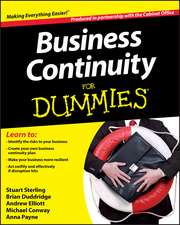The holding company and corporate control: Nijenrode Studies in Econometrics, cartea 3
Autor Herman P. Daemsen Limba Engleză Paperback – 10 oct 2013
Preț: 379.86 lei
Nou
Puncte Express: 570
Preț estimativ în valută:
72.70€ • 75.10$ • 60.50£
72.70€ • 75.10$ • 60.50£
Carte tipărită la comandă
Livrare economică 26 martie-09 aprilie
Preluare comenzi: 021 569.72.76
Specificații
ISBN-13: 9781461340584
ISBN-10: 1461340586
Pagini: 160
Ilustrații: X, 145 p.
Dimensiuni: 152 x 229 x 8 mm
Greutate: 0.22 kg
Ediția:1977
Editura: Springer Us
Colecția Springer
Seria Nijenrode Studies in Econometrics
Locul publicării:New York, NY, United States
ISBN-10: 1461340586
Pagini: 160
Ilustrații: X, 145 p.
Dimensiuni: 152 x 229 x 8 mm
Greutate: 0.22 kg
Ediția:1977
Editura: Springer Us
Colecția Springer
Seria Nijenrode Studies in Econometrics
Locul publicării:New York, NY, United States
Public țintă
ResearchCuprins
I. Introduction.- 1. Research subject and objectives.- 2. What is a holding company?.- 3. Previous literature and the contribution of this study.- 4. Plan of the study.- II. A Powerful Institution.- 1. Introduction.- 2. The history.- 3. The main characteristics of the Belgian holding company system.- 4. International comparison and the reasons for the stability and viability of the holding company.- 5. Managerial organization of control.- 6. Concluding remarks.- III. Holding Companies and Financial Intermediation: Theory.- 1. Introduction.- 2. The basic model: capital-asset-pricing in a two-parameter world.- 3. The case for and against security substitution by holding companies.- 4. Conclusion.- IV. Holding Companies and Security Substitutions: Evidence.- 1. Introduction.- 2. The statistical methodology.- 3. The sample.- 4. The empirical results.- 5. Conclusion.- V. Holding Companies and Corporate Control.- 1. Introduction.- 2. A methodology for measuring the control influences of the holding companies.- 3. Concentration of corporate power in the Belgian economy.- 4. The market for corporate control in Belgium.- 5. Concentration of corporate power and competition.- 6. Conclusion.- VI. Foundations for a Theory of Holding Company Behavior.- 1. Introduction: the holding companies’ problem.- 2. Control for the pure sake of control or power.- 3. Financial and economic benefits to control.- 4. Conclusion.- VII. Holding Companies, Investment Strategy and Economic Growth.- 1. Introduction.- 2. The retardation of the Belgian economy, revisited.- 3. Industrial structure and economic growth.- 4. Conclusion.- VIII. General Conclusion.










